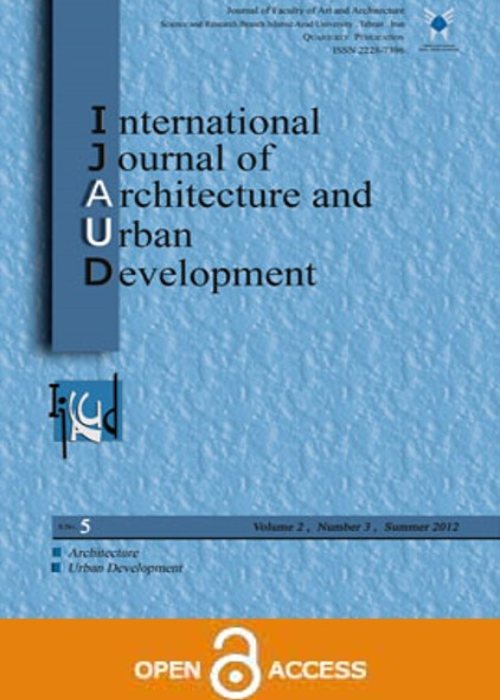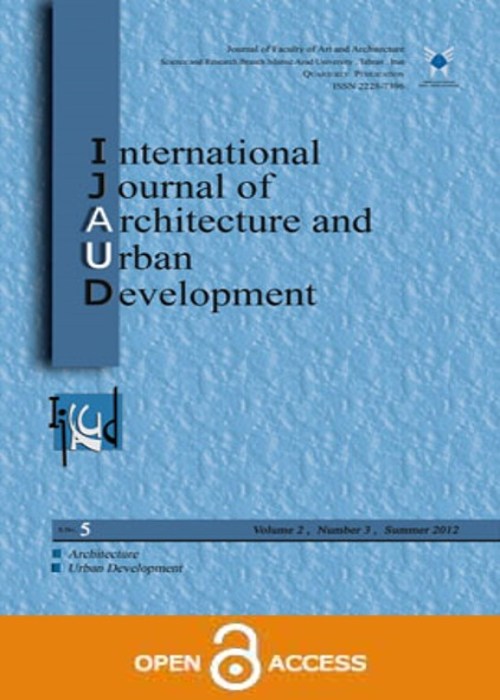فهرست مطالب

International Journal of Architecture and Urban Development
Volume:12 Issue: 4, Autumn 2022
- تاریخ انتشار: 1401/09/02
- تعداد عناوین: 6
-
-
Pages 1-16
The complete streets movement has been defined as the latest movement for providing safe streets for all modes of transportation and people of all ages and abilities through redesigning streets' spaces. The first phase in planning a successful complete street for any location is establishing a solid policy. To identify the key components of the firm policy, this study surveyed the highest-ranked complete streets policies in North America since the concept of the complete street has emerged in the USA. This study aimed to provide an exemplary policy structure for other societies to use as a model for developing successful complete streets policy in their communities. To support this effort, an integrated literature review made for an inclusive methodological approach. As a result, fundamental approaches to writing and defining an ideal complete street policy are clarified. Also, two characteristics outside the policy elements, which improved the policy's potential for success, are discovered.
Keywords: Complete streets, Complete Street Policy, Policy Main Elements, Policy Types -
Pages 17-26
The high consumption of non-renewable energy and fossil fuel pollution has been a significant issue in recent decades. The transportation sector, which is affected by travel patterns, has a substantial stake in energy use; these patterns depend on various factors, including social and economic factors. The purpose of this paper is to examine the effects of social and economic factors on energy consumption, with an emphasis on family travel patterns; for this purpose, the Malek-Shahr and Amir-Arab neighborhoods in Isfahan, Iran, were selected as the research cases. A mixed-paradigm methodology was used. The required information to examine the measures and the related factors was obtained by documentation and field study; the classified random sampling method was used to complete the questionnaires. In addition, the Mann-Whitney U test was used to examine the significant differences between the neighborhoods considering social, economic, and travel pattern variables. Also, factor analysis and regression were applied to carry out path analysis and explain how the factors and variables were related. The results indicate that the Malek-Shahr neighborhood has a significantly better social and economic status and more arbitrary travel patterns than the Amir-Arab neighborhood. It was also found that there was no significant relationship between the social factor and the travel patterns in both neighborhoods. The economic factor played a major role in this respect; this was more pronounced in the Amir-Arab neighborhood afflicted by a lower economic status.
Keywords: Social, Economic Factors, Energy Consumption, Travel Pattern, Malek-Shahr Neighborhood, Amir-Arab Neighborhood -
Pages 27-40
Education is affected by many factors, including mental and emotional conditions and the physical environment. The quality of architectural space in educational spaces, since it can affect students' sensory, intellectual and perceptual cognition, can also affect their satisfaction with the school environment. This research tries to identify satisfaction as one of the factors affecting the quality of school architecture and takes steps to improve the situation. In addition to addressing the basic needs, qualitative considerations are also addressed.
Research MethodIn this research, the documentary and survey research method (descriptive-applied) has been used to analyze adolescent girls' perception of the meaning of sexuality in society and compare it with their level of satisfaction with the educational environment. Through Cochran's formula, the statistical population of female high school students in Baneh city is 120 students. The results were analyzed in SPSS software.
FindingsThere is a perception and understanding of sexuality in female students. There is also a significant relationship between the perception of sexuality awareness in students and their satisfaction with the environmental quality of the school. The more students know about their gender, the better they understand and respond to the school environment
Keywords: Sexuality, Environmental Satisfaction, Baneh Secondary Schools -
Pages 41-52
Environmental dimensions can be used as indicators of urban quality of life due to their potential contribution to subjective well-being. The environment is constituted by the interacting systems of physical, biological, and social elements interrelated in various ways, individually and collectively. This study aims to uncover qualitatively whether these two environmental elements, namely social and physical factors, are indeed predictors of subjective well-being and reliable indicators of quality of life in cities. The study presents and tests a model that examines a matrix of cross-effects between social and physical indicators with subjective well-being. Data are obtained through an expert survey in the city of Tehran. In this approach, a group of urban planners undertakes the effect of social and physical components on subjective well-being. First, the existing literature is studied, and the related components are identified. Then, some interviews are made, and the cross-section analysis effects are extracted in a cross-effect matrix. As the finding revealed, among physical factors, percapita and spatial justice can have the highest impact on subjective well-being in Tehran. This was followed by access to urban transportation networks depending on their type, quality, and amount. Also, commute, neighborhood, housing, and job satisfaction were predictors of subjective well-being. Among social factors, spending leisure time, continuous social interactions, and health status impact subjective well-being.
Keywords: Subjective Well-being, Environmental Dimension, Social Elements, Physical Elements, Spatial Justice -
Pages 53-66
Augmented reality (AR) builds better participation for placemaking by focusing on real time features, communication, and direct information flow between project stakeholders. This study attempts to access to specification of the Augmented Reality System for Placemaking (ARSP) model and make the research a basis for a profitable e-business model. By investigating AR and placemaking, this research seeks to build an augmented reality system specification of the information flow and communication for project stakeholders' management. This paper explores the potential for using AR technology in interior design by three-dimensional (3D) and two-dimensional (2D) and façade placemaking by 2D textures of brick material. The system consists of a qualitative proof of concept (POC) model, a prototype model, and a minimum vital product (MVP) model to study to compel quantitative research. The ARSP POC model, prototype model, and MVP model are programmed by building an information modeling (BIM) system, Revit and Unity software, and different software development kits (SDKs) as an application for Android devices. Seventy-four experts tested the MVP model in the Delphi method and observed, interviewed, and filled out a questionnaire. The research shows that the contributions of this study to the body of knowledge are twofold. First, this study extends the understanding of AR applications in placemaking. Second, this study identifies possible improvements using AR systems in design, procurement, and construction.
Keywords: Augmented reality, placemaking, design, construction, procurement, system specification, stakeholders management -
Pages 67-84
Need to solve the housing problem, the formation of experimental projects and the design and construction of new organized concepts have been done. One of the areas that, due to the development of industries, contains various examples of corporate housing is the city of Ahvaz. The present study intends to explain these concepts by recognizing the components of optimal housing containing internal and external characteristics in these complexes. The research method in terms of applied-developmental goal and mixed technique includes; Descriptive methods and content analysis in the theoretical and correlational sections are comparative, and field in the case studies section. The type of simultaneous variable design combines quantitative and qualitative approaches with a theoretical framework. Finally, based on the conceptual model, In the first step to finding descriptive statistics, questionnaires with answers from the Likert spectrum according to the sample size are provided to the residents of 105 units on the news site and 66 units in the water and electricity dormitory for analysis by SPSS software In the next step, interviews based on research questions from a community of 10 experts who were selected by snowball method are compiled and inferential statistics are extracted by analyzing them. After introducing the results of two areas, quantitative and qualitative, and to achieve the desired housing components, a link between human factors, physical-social factors, and decision-making factors should be established. Strategies should be presented in the short, medium, and long term.
Keywords: Housing, Organizing concepts, Architecture, Urban planning, Corporate town


